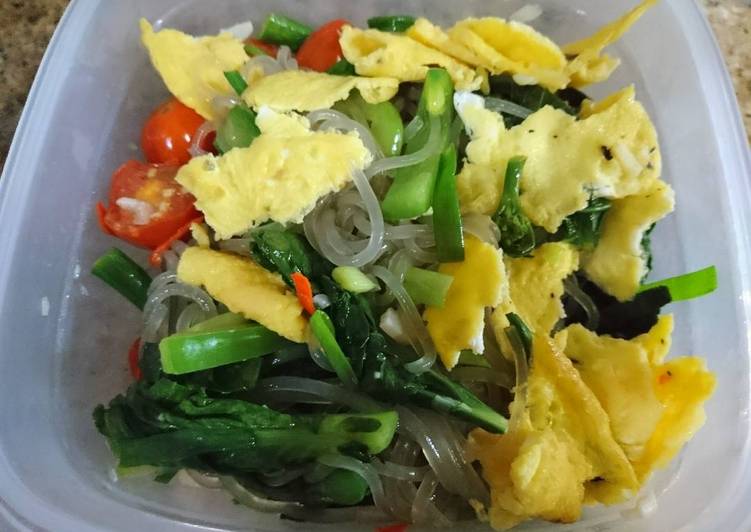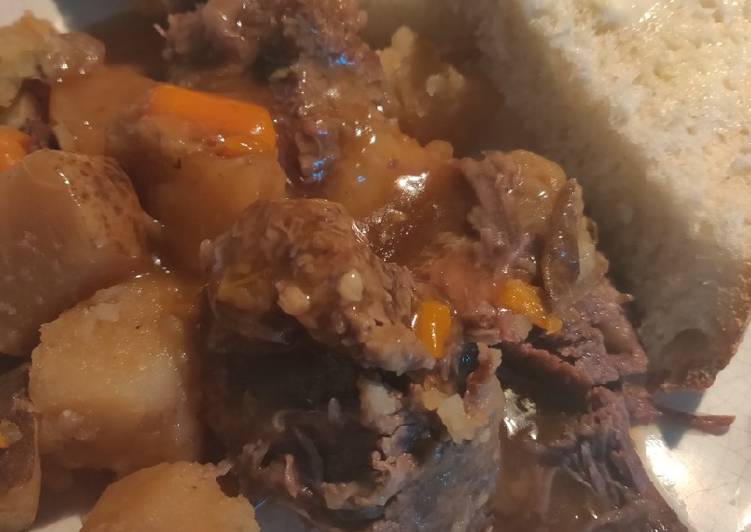
Hey everyone, hope you’re having an incredible day today. Today, I’m gonna show you how to make a special dish, korean japchae (sweet potato noodle). One of my favorites food recipes. For mine, I will make it a bit unique. This will be really delicious.
Korean japchae (sweet potato noodle) is one of the most well liked of recent trending foods on earth. It is appreciated by millions every day. It is easy, it is fast, it tastes delicious. They’re nice and they look fantastic. Korean japchae (sweet potato noodle) is something which I’ve loved my entire life.
Beef, carrot, eggs, garlic, green onion, ground black pepper, onion, red bell pepper, salt, sesame oil, sesame seeds, shiitake mushrooms, soy sauce, spinach, starch noodles, sugar, vegetable oil, white oyster mushrooms. Made with bouncy sweet potato starch noodles, dangmyeon, japchae (or chapchae) is a classic Korean dish everyone loves! Japchae (잡채) literally means "mixed vegetables." But the main ingredient of this classic dish is Korean sweet potato starch noodles (dangmyeon), also known as.
To begin with this particular recipe, we must first prepare a few components. You can have korean japchae (sweet potato noodle) using 12 ingredients and 10 steps. Here is how you can achieve it.
The ingredients needed to make Korean japchae (sweet potato noodle):
- Prepare Sweet potato noodles
- Get Garlic
- Get Chilli padi
- Get Cherry tomato
- Take Baby kailan
- Take Bell pepper (capsicum, any colour you want)
- Make ready Egg
- Take Spring onions
- Get Sesame oil
- Take Light soy sauce
- Make ready Mushroom powder
- Get Sugar
They are made using only sweet potato starch and water. Bonus: Sweet potato glass noodles are low-carb and gluten free! The sweet potato noodles are tossed with beef and veggies in a sweet savory sauce. Make japchae at home if you want a comforting, delicious, and nutritionally balanced meal for your weekday dinner.
Instructions to make Korean japchae (sweet potato noodle):
- Cut the baby kailan, separate the stem and the leaves part.
- Cut cherry tomato to half. Cut bell peppers to thin cuts.
- Cut spring onions to 2cm size. Crushed and diced the garlic. Cut chilli padi.
- Heat up sesame oil. Put in garlic, baby kailan stem and stir fry until the leaves start to change color.
- Put in bell peppers, tomato. Stir fry. Put in mushrooms powder, cut chilli padi and sugar.
- Put in the rest of baby kailan leaves. If you like your spring onions crunchy, turn off the fire and add in spring onions. Mix it a bit and set aside. If you like your spring onions cooked just leave them with the fire on for a while.
- Boil japchae for 8 minutes or you can soak it with hot water for an hour. After soaking it just stir fry it a bit and it will become transparent. After boiling it you can strain the noodles and put in ice water if you want more chewy texture.
- Mix japchae with sesame oil and light soy sauce.
- Beat the egg and put mushroom powder in. Make a thin layer of egg on the pan. You can cut them into thin strips or just shredded them randomly with chopsticks like I did.
- Mix japchae, stir fried vegetables and egg together. They are ready!
The tender sweet potato noodles are tossed with charred beef and crispy veggies in a sweet. This classic Korean noodle dish combines translucent sweet potato noodles with lots of stir-fried vegetables and a sweet-savory sauce. What to buy: Korean sweet potato noodles, also known as starch noodles or Korean vermicelli, are made from sweet potato starch and water. If adding broccolini, hot water blanch them for a few minutes. Japchae (also spelled as chap chae) is my favorite Korean noodle dish.
So that is going to wrap this up for this special food korean japchae (sweet potato noodle) recipe. Thank you very much for your time. I’m confident you will make this at home. There’s gonna be more interesting food at home recipes coming up. Remember to bookmark this page on your browser, and share it to your family, colleague and friends. Thanks again for reading. Go on get cooking!

